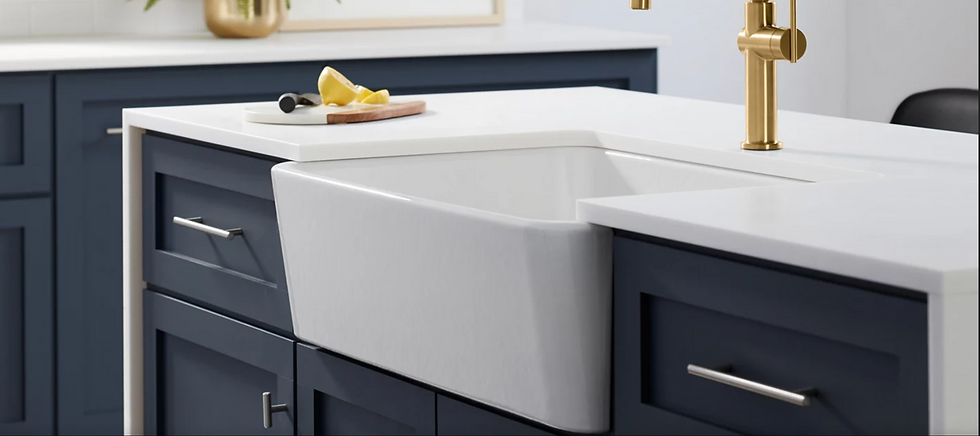Sink Types
- Mauricio Coto

- May 9, 2023
- 3 min read
Updated: Jun 27, 2023
When it comes to kitchen and bathroom design, sinks are an important consideration. Not only are they a functional element, but they can also be a key design feature. There are several different types of sinks available, each with its own advantages and disadvantages. In this blog post, we'll take a look at the most common types of sinks and what sets them apart.
Undermount Sink
An under-mount sink is installed underneath the countertop, with the lip of the sink hidden beneath the countertop's surface. This type of sink is popular because it provides a clean, seamless look that works well in modern and contemporary kitchens. Undermount sinks are available in a variety of materials, including stainless steel, porcelain, and granite.
One of the main advantages of under-mount sinks is that they are easy to clean, as there are no ridges or edges where dirt and grime can accumulate. However, they can be more difficult to install than other types of sinks, and they require a solid surface countertop that can support the weight of the sink.
Drop-In Sink
A farmhouse sink, also known as an apron-front sink, is a large, deep sink with a front panel that extends beyond the edge of the countertop. This type of sink is popular in rustic and traditional kitchens, as it provides a classic and charming look.
Farmhouse sinks are available in a variety of materials, including porcelain, stainless steel, and copper. They are often deeper and wider than other types of sinks, making them ideal for washing large pots and pans.
One disadvantage of farmhouse sinks is that they can be more difficult to install than other types of sinks, as they require a special cabinet that can support the weight of the sink. They are also more expensive than other types of sinks, making them a less practical choice for some homeowners.
Vessel Sink
A vessel sink is a bowl-shaped sink that sits on top of the countertop rather than being installed beneath it. This type of sink is popular in contemporary bathrooms, as it provides a unique and eye-catching look.
Vessel sinks are available in a wide range of materials, including glass, porcelain, and stone. They can be found in a variety of shapes and sizes, making them a versatile option for homeowners looking to add a modern touch to their bathroom.
One disadvantage of vessel sinks is that they can be more difficult to clean than other types of sinks, as there are ridges and edges where dirt and grime can accumulate. They are also less practical for small bathrooms, as they can take up more counter space than other types of sinks.
Wall-Mounted Sink
A wall-mounted sink is attached directly to the wall and does not require a countertop. This type of sink is popular in small bathrooms or powder rooms, where space is limited.
Wall-mounted sinks can be paired with a wall-mounted faucet or a countertop-mounted faucet. This type of sink is easy to clean, as there are no ridges or edges where dirt and grime can accumulate. Wall-mounted sinks are also a good option for wheelchair accessibility, as they can be installed at the appropriate height.
However, wall-mounted sinks have a limited amount of counter space, which can make them less practical for larger bathrooms. They also require more planning and preparation during installation, as the wall must be able to support the weight of the sink.
Pedestal Sink
A pedestal sink consists of a basin that sits on top of a tall, slender pedestal. This type of sink is popular in small bathrooms or powder rooms, as it takes up less space than a traditional vanity.
Pedestal sinks are available in a variety of styles and materials, making them a versatile option for homeowners looking to add a classic or modern touch to their bathroom. They are also easy to clean, as there are no ridges or edges where dirt and grime can accumulate.
One disadvantage of pedestal sinks is that they provide limited storage space, as there are no cabinets or drawers beneath the sink. They can also be less practical for larger bathrooms, as they do not offer as much counter space as other types of sinks.
In conclusion, there are several different types of sinks available, each with its own advantages and disadvantages. When choosing a sink for your home, it's important to consider factors such as aesthetics, functionality, and budget. By understanding the different types of sinks available, you can choose a sink that not only looks great but also meets your practical needs.


Comments